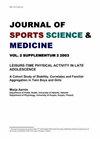利用9/3分钟跑步临界功率测试预测半程马拉松的功率目标。
IF 2.4
2区 医学
Q2 SPORT SCIENCES
引用次数: 0
摘要
运行功率输出允许控制以前仅仅依赖于速度而忽略的变量,如表面、坡度和重量。测量这种外部负载变量的能力现在可以分析在循环中主要研究的概念,例如在运行环境中的临界功率(CP)。本研究旨在预测训练有素的运动员跑半程马拉松时的CP目标,并确定该距离的比赛是否可以作为更新CP记录的有效替代。一组9名训练有素的运动员进行了9/3分钟的Stryd CP测试,并参加了在现场进行的两次独立测试的半程马拉松比赛。半程马拉松比赛期间的平均功率是确定训练有素运动员CP的有效替代方法,证明了方法之间的一致性(95% CI: -0.11至0.37 W/kg)和微不足道的系统偏差(0.13 W/kg)。半程马拉松功率= 0.97 + 0.75·CP (W/kg)的线性回归模型表明,估计的标准误差较低(0.29 W/kg),方法之间的相关性显著(r = 0.88;P = 0.002)。教练和运动员应该知道,半程马拉松比赛的CP目标是由9/3分钟Stryd CP测试确定的CP的97.3%。本文章由计算机程序翻译,如有差异,请以英文原文为准。
Prediction of Half-Marathon Power Target using the 9/3-Minute Running Critical Power Test.
Running power output allows for controlling variables that have been previously overlooked by relying solely on speed, such as surface, gradient and weight. The ability to measure this external load variable now enables the analysis of concepts that have predominantly been studied in cycling, such as the Critical Power (CP), in the context of running. This study aims to predict the CP target at which trained athletes run a half-marathon and determine whether races of this distance can serve as a valid alternative to update the CP record. A group of nine trained athletes performed the 9/3-minute Stryd CP test and participated in a half-marathon race in two separate testing sessions conducted in the field. The average power during a half-marathon race is a valid alternative method for determining the CP in trained athletes, as evidenced by the agreement (95% CI: -0.11 to 0.37 W/kg) and trivial systematic bias (0.13 W/kg) between methods. The linear regression model half-marathon power = 0.97 + 0.75·CP (W/kg) showed low standard error of estimate (0.29 W/kg) and significant large association between methods (r = 0.88; p = 0.002). Coaches and athletes should be aware that the CP target for a half-marathon race is 97.3% of the CP determined by the 9/3-minute Stryd CP test.
求助全文
通过发布文献求助,成功后即可免费获取论文全文。
去求助
来源期刊
CiteScore
5.60
自引率
6.20%
发文量
56
审稿时长
4-8 weeks
期刊介绍:
The Journal of Sports Science and Medicine (JSSM) is a non-profit making scientific electronic journal, publishing research and review articles, together with case studies, in the fields of sports medicine and the exercise sciences. JSSM is published quarterly in March, June, September and December. JSSM also publishes editorials, a "letter to the editor" section, abstracts from international and national congresses, panel meetings, conferences and symposia, and can function as an open discussion forum on significant issues of current interest.

 求助内容:
求助内容: 应助结果提醒方式:
应助结果提醒方式:


